
Key considerations
• Available for £28,000
• 2.0-litre inline-four turbo petrol, all-wheel drive
• World’s most powerful four-cylinder engine, so it goes like stink
• Very configurable chassis, clings on forever
• Quality improved over W176 gen-one, but there have been issues
• Post-’23 models look more like ‘proper’ AMGs
What’s the first word that comes into your head when someone says ‘AMG’? For most of us, that word will probably be ‘power’. Mercedes might not be dominating Formula 1 at the moment but during 2025’s Chinese GP Ferrari’s Charles Leclerc expressed shock at the way the W16 F1 car tramped its way out of corners, describing it as ‘a dragster’.
That core AMG attribute of thumping power is now in full effect at both extremes of the M-B proposition, having been successfully trickled down to Mercedes’ smallest production cars. The first A45 version of the gen-three W176 entered the hot hatch market with a hell of a bang in 2013, its 2.0-litre turbo four knocking out a startling 360hp. Hooked up to a Speedshift seven-speed dual-clutch transmission and 4Matic all-wheel drive, it covered the 0-62mph sprint in 4.6 seconds and went on to a top speed (with the Driver’s Pack) of 168mph.
The W176 A45 facelift was even madder, generating 381hp from the same engine to make it the most powerful hot hatch ever. Until Audi made the RS3 faster still. The AMG marched through the 0-62 in a supercar-rivalling 4.2 seconds. A decade or so earlier you would have had to buy something mid-engined and low-slung to get into that sort of power and performance, and yet there we were experiencing it in a five-door hatchback.
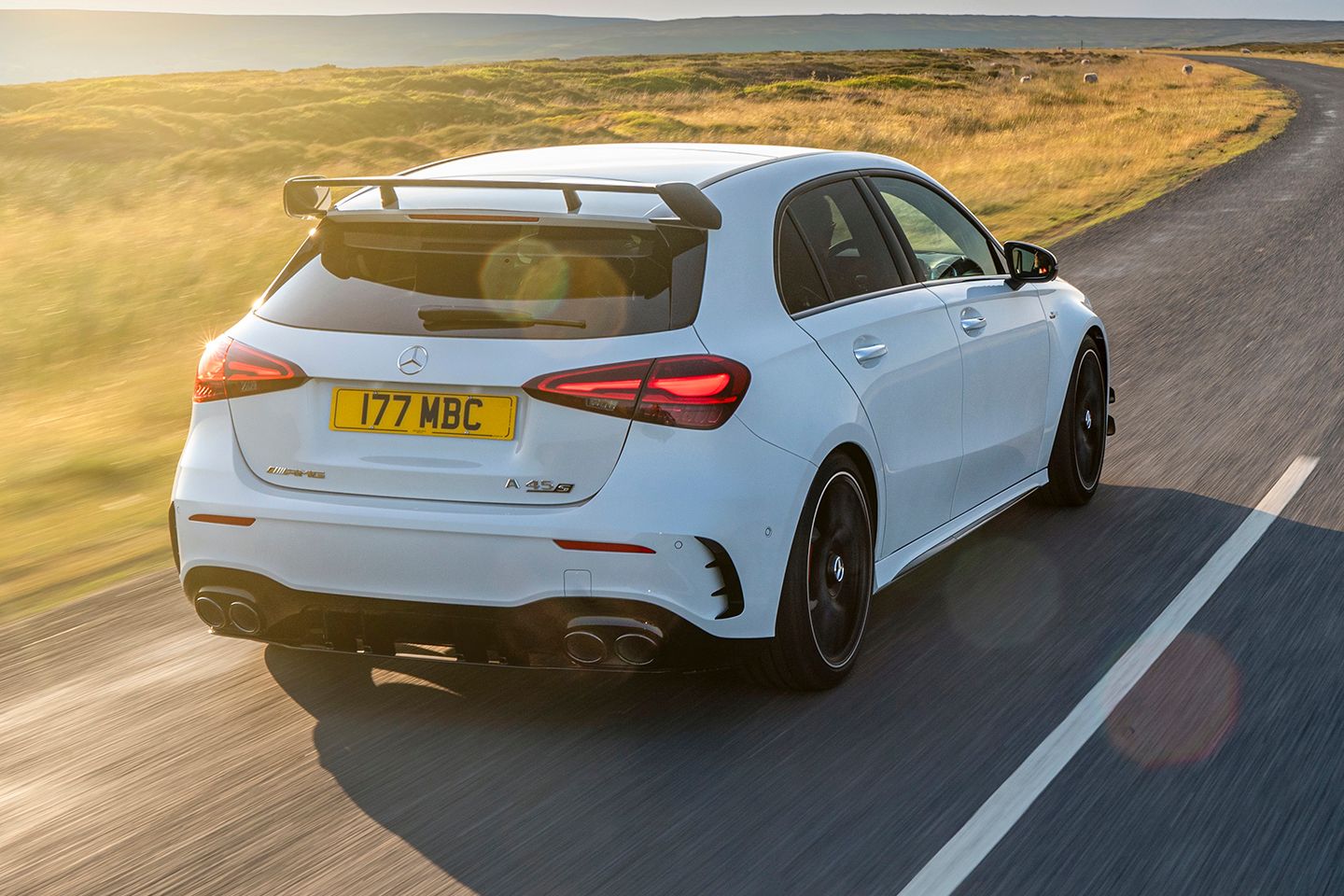
It made you wonder what sort of numbers were going to be bandied around for the AMG version of the gen-four W177 A-Class that was unveiled at the 2018 Geneva show. As it turned out, the answer to that was ‘even more than ever’. The W177 A45 S (which was the only model available in the UK, the 382hp non-S not being sold here) was rated at 421hp, with 369lb ft, making it the most potent series production hatchback ever made. Thanks to an eight-speed DCT gearbox replacing the old seven-speed and the additional wallop, the 0-62mph time dipped below four seconds.
A general A-Class facelift was revealed in October 2022 for 2023 cars. This brought new lights front and rear, a redesigned interior, a new Benz MBUX infotainment system, and some new trim and paint choices. On the A45 S version, nothing changed in terms of power, torque or top speed, but the lairy AMG Aerodynamic Package moved from optional to standard, the steering wheel from higher-grade AMG models was bolted in, and there was an Affalterbach AMG badge on the bonnet in place of the Mercedes star. In mid-2023 the price for this refresh model was £63,910.
They’re still making it today, so how much does a 2025 Mercedes-AMG A45 S car cost now? £63,745 according to the configurator – prices are coming down after all. Still, quite a hike on the 2020 price of £50,570. Fortunately, you don’t have to spend that much to enjoy the unique charms of a W177 A45 S. Used ones start at around £28,000. That will get you into a 2019 or 2020 car with 60,000 miles on it. 2023-on refresh models are of course more expensive, being both newer and lower mileage, but we suspect there’s an extra kick up in values as a result of the extra AMG-isation brought about by the new bonnet badge and steering wheel.
SPECIFICATION | MERCEDES-AMG A45 S (W177 2019-)
Engine: 1,991cc, inline four, turbocharged
Transmission: 8-speed dual-clutch automatic, all-wheel drive
Power (hp): 421@6,750rpm
Torque (lb ft): 369@5,000-5,250rpm
0-62mph (secs): 3.9
Top speed (mph): 168
Weight (kg): 1,635
MPG (WLTP combined): 25.5-26.7
CO2 (g/km): from 189
Wheels (in): 19
Tyres: 245/35
On sale: 2019 – now
Price new (2020): £50,570 (£63,910 ‘23 refresh)
Price now: from £28,000
Note for reference: car weight and power data are hard to pin down with absolute certainty. For consistency, we use the same source for all our guides. We hope the data we use is right more often than it’s wrong. Our advice is to treat it as relative rather than definitive.
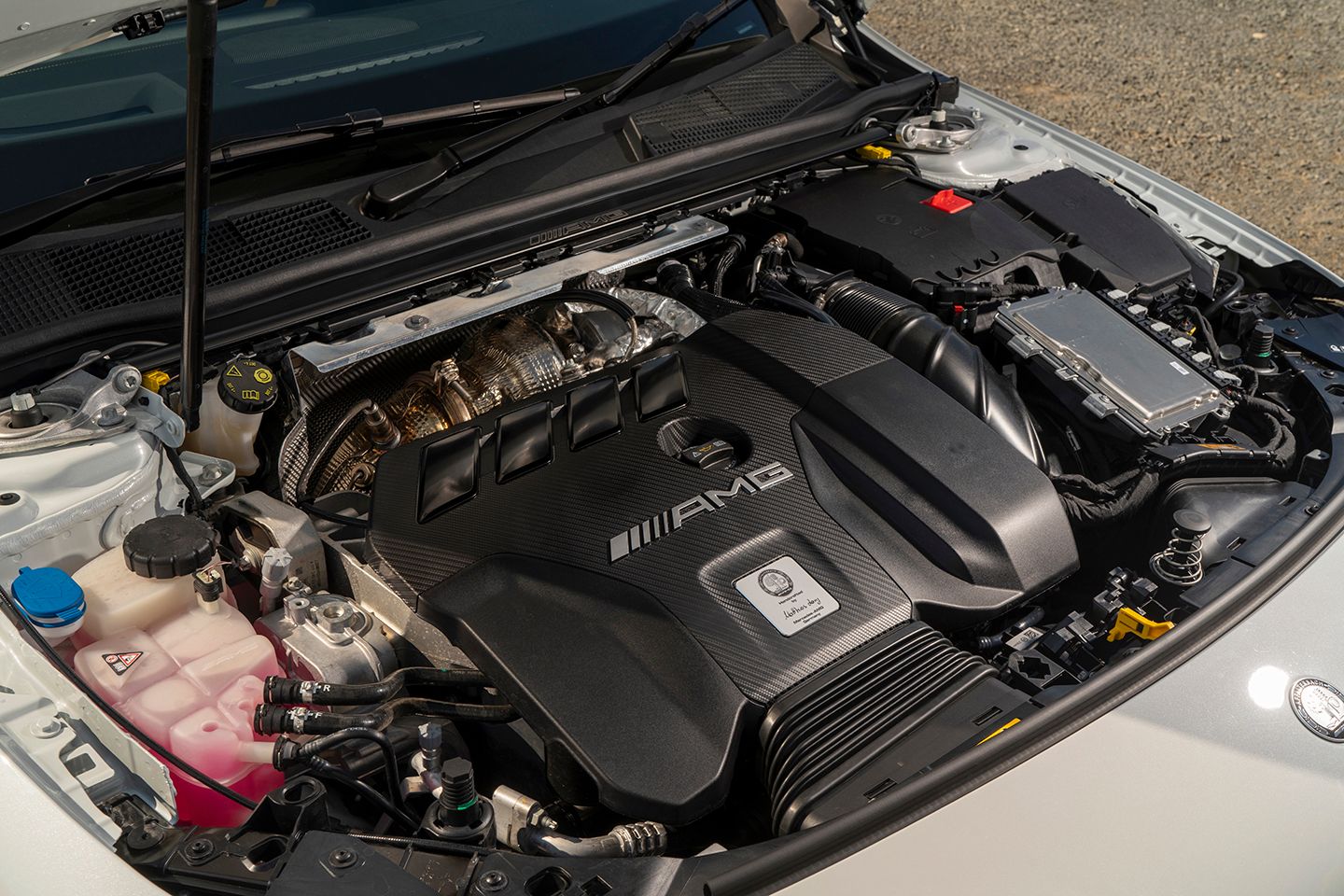
ENGINE & GEARBOX
The M139 is still the world’s most powerful 2.0-litre production engine, which should be enough of an achievement on its own to make you want one. But it wasn’t just the rampant thrust that was so impressive – it was the fact that it was so usable. Back in the day, the price for big power from a small engine was greatly reduced tractability. That could turn any car into a major pain, but the A45 S came with no such compromises. Though it was turbocharged, the linear power flow gave it a naturally aspirated feel. It was a highly civilised and potent unit that was just as happy pottering along as it was delivering face-melting acceleration up to and beyond the 6,750rpm peak power mark. If you were using the eight-speed twin-clutch gearbox in manual mode you needed good timing to chuck in the next cog as the ratios were very closely stacked and the stutter point came up with indecent haste. Both the 177 and the earlier 176 had launch control, but the newer car was quicker through the 0-60 by (roughly speaking) a full second in normal conditions. It built on that advantage in kickdown roll-ons, easily leaving the old car behind despite weighing 80kg more.
For those who wanted to widen that gap still further, power upgrades were widely available. Stage 1 packages lifted power to around 460hp, while stage 2 gave you 500hp and 465lb ft, reducing the 0-60mph time to something in the low threes. At those levels of power, you might start to notice some shortcomings in gearshift smoothness because the gearbox ECU was locked by the factory so it couldn’t be remapped to allow the trans to get on better with extra power. Even on unmodified cars the gearbox could be quite slow to react to a demand for reverse.
The quad exhausts weren’t real. The old A45 committed the same sin of impersonation but not quite as blatantly, its two outlets being basically single exhausts made to look like twins by cosmetic tailpipe dividers. For legal reasons, exhaust noise levels generally were knocked back somewhat compared to the W176, but if you hadn’t driven the earlier car you would probably be more than satisfied by the W177’s artificially (but cleverly) enhanced cabin noise which included a decent selection of pops and bangs on both up and downshifts. Not so much on the outside, on unmodified cars anyway, which would please anyone unlucky enough to live on a road used by drivers who thought everyone should hear all their cars all of the time.
Engine warning lights have popped up. These have usually been caused by faulty sensors. Having said that, this engine is obviously running closer to commonly accepted mechanical limits than most others, so it pays to keep a close eye on the integrity of pressure points like seals and gaskets and on oil levels. Cooling could be an issue, too, if you were regularly giving your A45 S the beans on tracks or drag strips. Allowing the turbo a bit of cooldown time after a fast run has never been bad advice for as long as turbos have been present in cars. There was a recall in Australia for seven 2020-manufactured cars to address faulty spark plugs that could break, potentially resulting in parts dropping into the engine, but we couldn’t find any reference to that outside Oz.
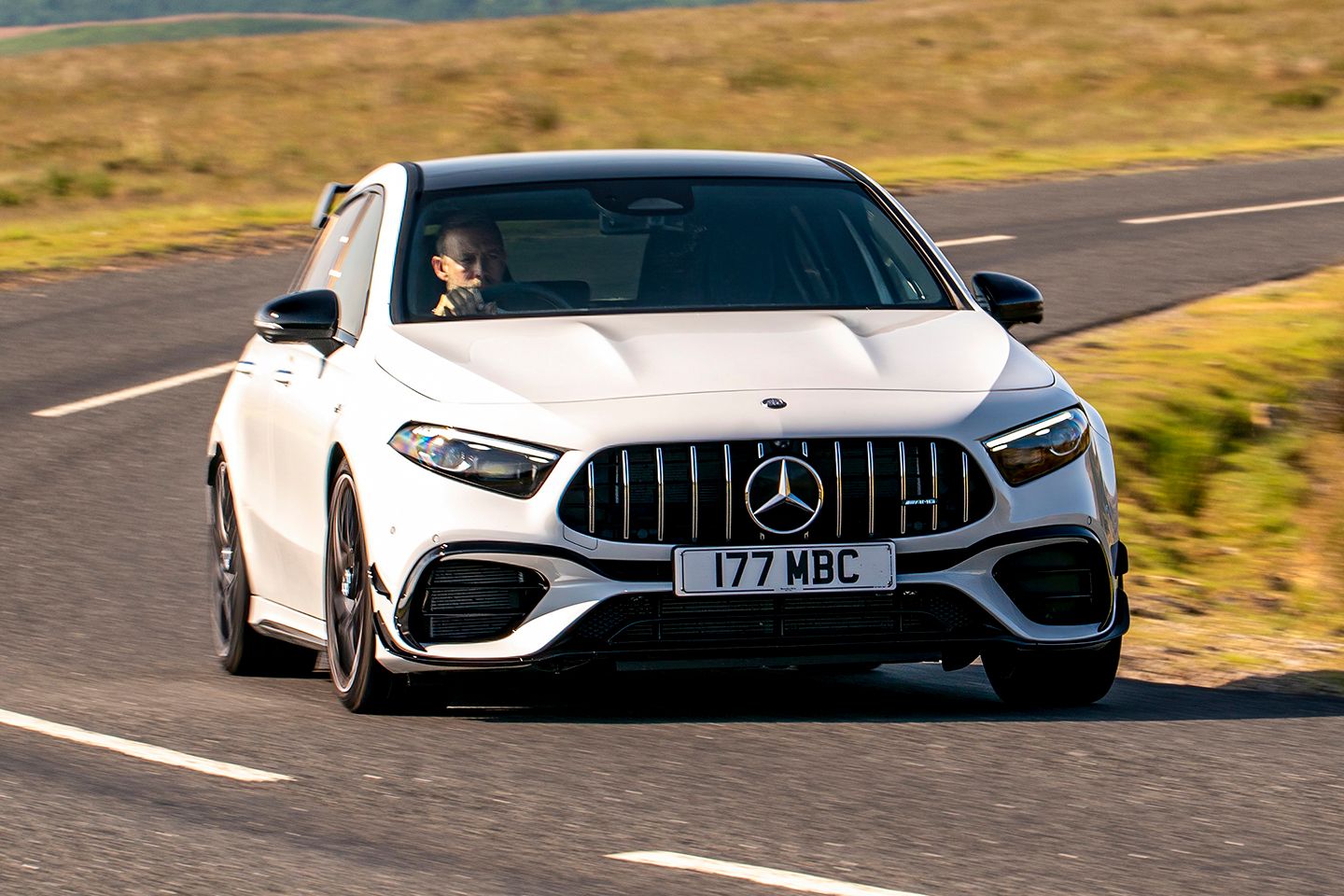
CHASSIS
Both old and new A45s were tremendously effective at covering the ground in a timely manner, but the W177 A45 S with its slightly wider front track and lower, stiffer suspension was a more tactile and more entertaining experience. Its all-wheel drive system with mechanical sport differential at the rear could send 50 per cent of the engine’s power to the back of the car and, once there, up to 100 per cent to whichever rear wheel had the best chance of using it. Overspeeding the outside rear wheel helped to point the car into bends. Engaging Drift Mode (standard on the W177 but not on the W176) by choosing Race on the drive select, disabling stability control, putting the trans into manual mode, pulling up both gear paddles and confirming that you really wanted Drift Mode by pressing the Up button got you sliding in a playful and controllable manner.
Outside of Drift Mode the system provided magnetic grip on most corners. If the corners you mainly frequented were of the bumpy variety, AMG Ride Control adaptive suspension option (standard on the 2023-on refresh models) sorted that out. Some thought the A45 S wasn’t quite as engaging as the best front-drivers, but we’d venture to suggest that the vast majority of ordinary folk would be delighted by its well-judged balance of grip and safety.
In late 2024 following complaints about unusual noises from the rear end there was some recall activity to replace the A45 S’s rear axle ‘flex disk’ and to install a new shield for that, a £900 job carried out free of charge by dealerships. There have been a few delays on that work as a result of various parts delays and mixups. We think there was a power steering recall too but we haven’t been able to dig up any substantive info on that.
The A45 S came with 19-inch wheels as standard. Both old and new A45s had 330mm rear brake discs but the new A45 S’s front discs were 10mm bigger at the front and it had six-piston calipers there as against the old car’s four. Despite having an extra 80kg to stop the new car hauled up in a shorter distance than the old one. Some cars have thrown up ‘suspension malfunction, do not exceed 50mph’ messages. These were usually traced back to level sensor faults which could be cleared.
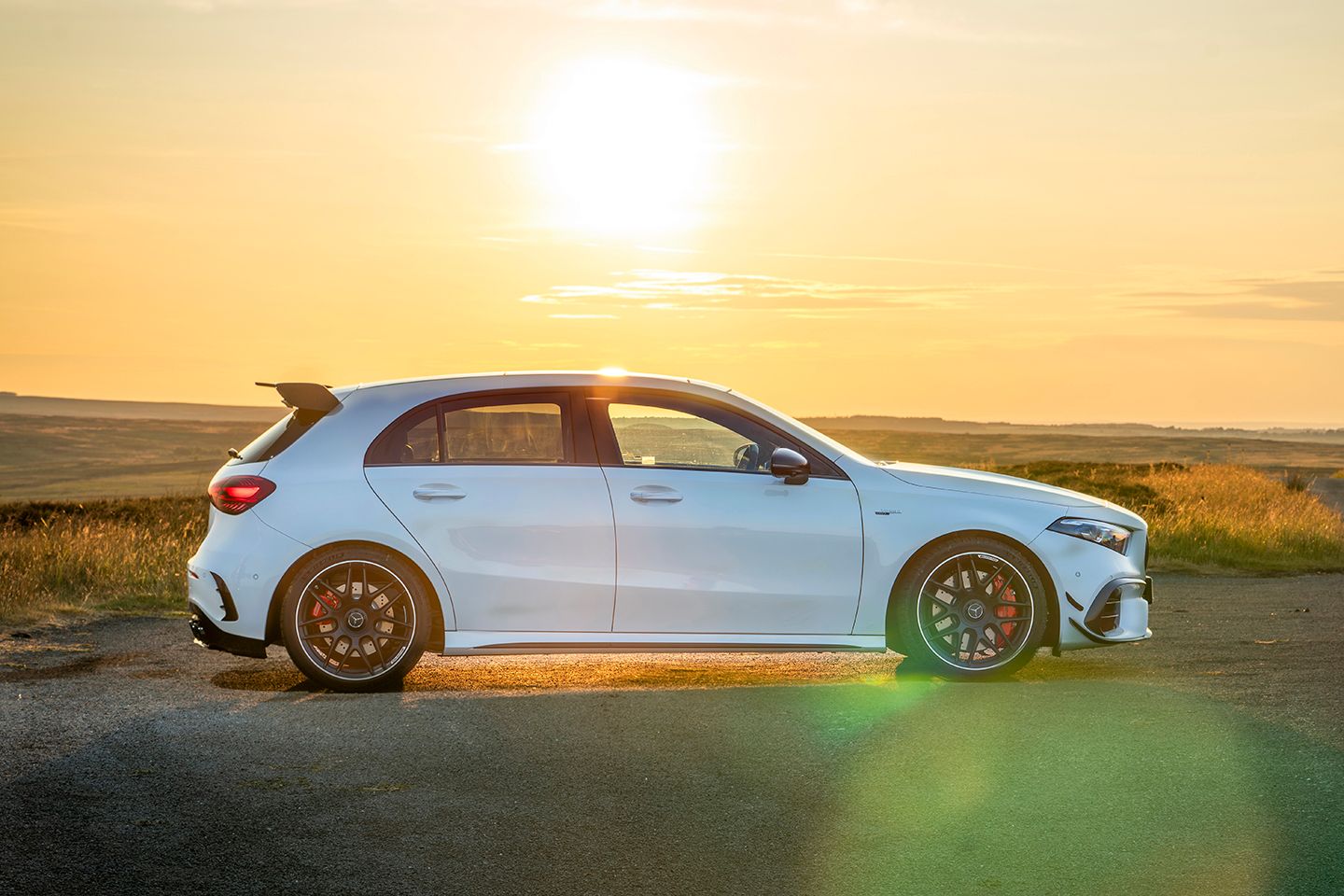
BODYWORK
The A45 S 4Matic+ Plus, to give it its full name, was only available as a five-door hatchback. If you wanted a saloon you had to settle for the A35, the 300hp one rather than the A35 that Austin made. The biggest visual change for the W177 was a switch from the old horizontally-split smiley face grille to the new angry face grille with vertical slats. New slimline headlights, a deep front splitter and more pronounced front ‘vents’ (fake, as were the rear ones) were part of the transformation that made the old car look, well, old. Some might prefer the old look of course.
If you crashed your A45 S, which a few owners did, you would be comforted by its five-star Euro NCAP test score. A comprehensive package of safety aids did its best to reduce both the possibility and the after-effects of crashing. Active blind spot assist, active lane keeping and a multistage electronic stability control system were all standard.
If the car you end up buying doesn’t have the big spoiler you really wanted, no worries: the aftermarket jumped to attention when the A45 came out, and there is now all manner of carbon fibre tomfoolery to indulge yourself in, not just roof spoilers but also bonnets, diffusers and splitters.
Door alignments weren’t always great, especially on early cars. Puddle lights have fallen out of doors, eventually leading to them being damaged by door closures. That was a warranty fix. Rear parking sensors have malfunctioned causing false warnings and/or the brake assist function to activate while you were reversing, even when there were no obstacles to warrant it.
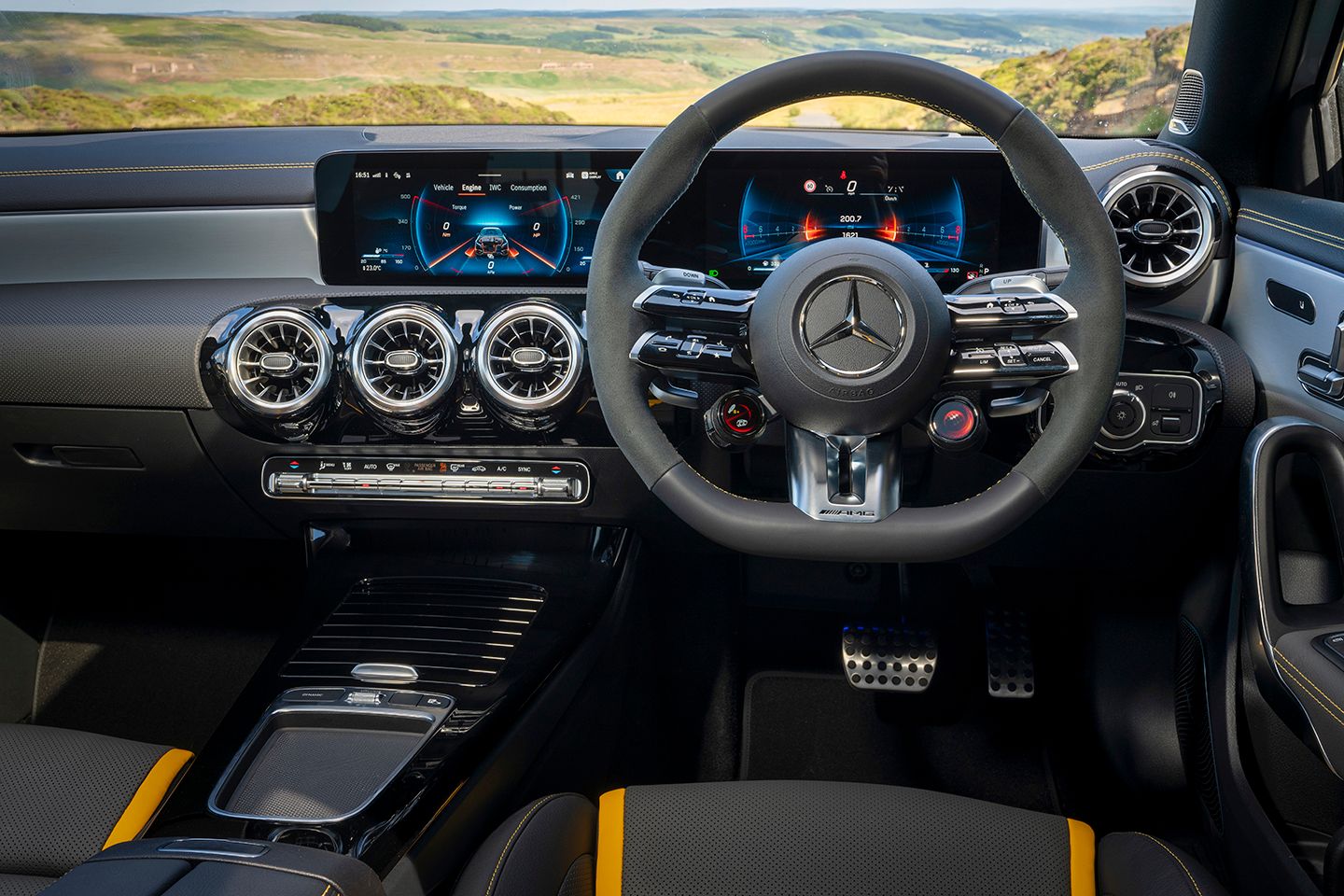
INTERIOR
Not everybody admired the look of the W177’s massive, dual 10.2-inch-screen setup with AMG-bespoke digital driver dials straight ahead and a central touchscreen for the infotainment, but you couldn’t deny its modernity. It certainly made the old W176’s interior with its twin analogue dials and rounded-off dash-mounted infotainment screen look either dated or classic, depending on your view.
The old centrally placed gear selector was replaced by a column stalk, which when you write it down in a sentence sounds weird, but in reality the column arrangement was more user-friendly. You got Apple CarPlay, Android Auto, two-zone climate control and 64-colour ambient lighting. The ‘hey Mercedes’ voice control system was nicely sharpened up for the W177. If it wasn’t able to answer your needs directly it could tell you how to get where you needed to be via the touchscreen. Augmented reality worked with the sat nav to layer helpful arrows over live video.
Some owners have complained about the volume of what they considered to be spurious error messages. In some cases, these were technically correct but you could say the car was being a bit pernickety. The tiniest of top-ups would sort out a low coolant warning, for example. Having said that, in some cases M-B replaced coolant reservoirs under warranty to effect a permanent cure so there was something amiss there somewhere. Some bogus warnings were traced back to a dodgy wire under the steering column cover.
Premium Plus spec added a pano roof, door and bootlid closing aids, nappa leather seats, a fragrance system, uprated 590-watt Burmester surround audio and massage seats. In general terms, interior quality took a big step forward in the W177 but not all of the AMG’s cabin materials felt premium, and there was a fair amount of road noise and occasional creakiness to put up with. One owner reported having dampening materials put into his B-pillars four times by the dealer to quieten buzzing and rattling, with no resolution reached. The same person also had a lot of rattling from the rear parcel shelf area. Large quantities of foam tape helped, but only for the short term.
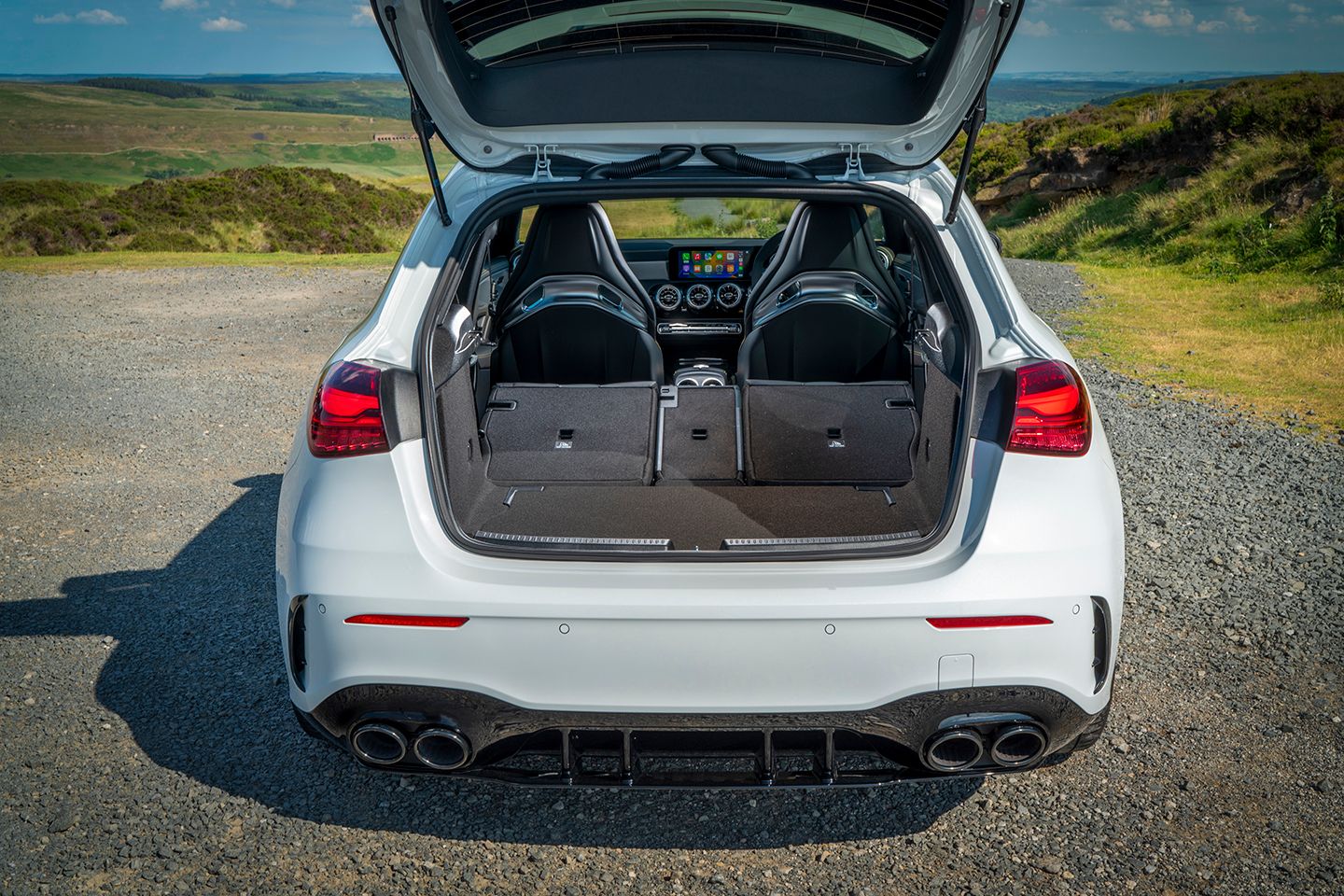
The Performance seats were well-shaped to hold front passengers in place during hard cornering. Some found the padding to be on the severe side of firm, and forgotten memory settings have been a thing for some. Seat belt knocking was another common problem for anyone who didn’t know that the top part of the Performance seat nearest to the B-pillar had a magnet in it to stop that from happening.
There were more USB ports in the 2024 facelift cars plus a new sage grey upholstery option, but the centre console touchpad was binned, which some thought a shame especially as the storage platform that was left wasn’t big enough for most smartphones. On the positive side, there was wireless phone charging and the touchscreen was pretty responsive although it has been known to black out. The buttons on the 2024 car’s new steering wheel were too responsive and too easy to hit by accident, leading to false phone calls and unwanted cruise control activation and audio volume changes. That was a pity because when you were using them deliberately they were very effective in customising the car’s responses for different driving environments.
An AMG Track Pace app was part of the MBUX package in the facelift cars. This gave you acceleration and lap times along with circuit-specific data. Technically at least three people could fit on the back seat but they wouldn’t be happy for long. The boot probably wouldn’t have taken all their luggage anyway, even though the 370-litre space was 30 litres bigger than the W176’s with significantly less intrusion by the rear light assemblies. It was slightly larger than the Audi RS3’s, too.
Air conditioning systems have failed, sometimes very early on in the car’s life. This was usually down to faulty O-rings near the compressor.
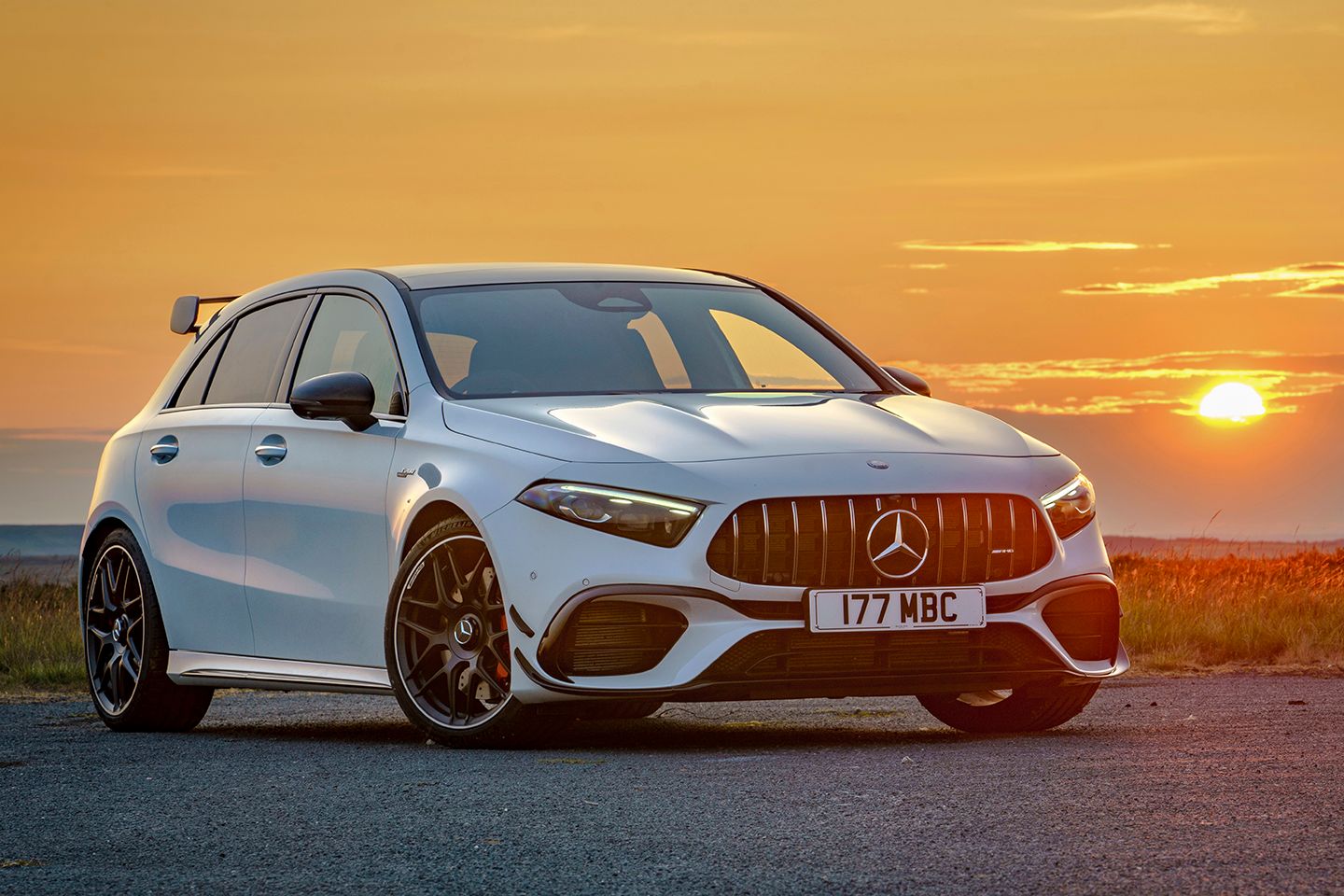
PH VERDICT
In our buying guide for the first 2013-18 A45 we said that the car began life looking like a mistake by Mercedes. Too many of them came onto the market too early, leading to a lot of pre-registered cars sitting unsold in dealerships. But then there was a very good refresh in 2016 which boosted power and improved the chassis and transmission, firming up that model’s residual values.
If you only looked at the data it was easy to see that the W177 moved the A45 game on significantly. It was measurably superior to the W176 in most aspects of its performance. The margin of its superiority did become a bit less obvious if you factored in human stuff like the sounds the two cars made. If you liked ’boostiness’ you would probably go for the older car, but the new one came with a different kind of thrashability and a welcome element of top-end revvability that combined well with the car’s ability to grip and keep on gripping at unlikely speeds.
When we did that gen-one A45 guide in August 2020 you could pick up a 360hp car for £17,000. Today you’ll have no trouble finding high-mileage (100-120k) gen ones for as little as £11,000, the engine/transmission woes which afflicted early cars having added some value-depressing unease. You’d think most of those troubles would have been sorted by now, possibly bringing some interest back to the leggy end of the W176 market for those prepared to take a chance, but this is one of those cars where forensic scrutiny of the service history is only half the battle. You’ll also need a high-spec crystal ball if you want to try and uncover what sort of life a car might have led. You could use that same ball to try and work out what will happen to A45 values in the future when M-B bins off the A-Class range sometime in 2026. We’re guessing that they’ll go up.
If you want this type of car but you’re not prepared to take the gen-one gamble, a gen-two will undoubtedly hold more appeal. It’ll cost you a lot more than a gen one though. As mentioned in the overview, the April 2025 entry price for an early second-generation car with 60,000 miles recorded was £28,000. The most affordable W177 A45 S on PH at the time of writing was this 31,000-miler from 2020 at £32,520. The most expensive was this 3,000-miler from 2024 at £55,000. Without going to the bother of working it out, our feeling is that the median price of the PH range is somewhere in the mid- to high-£40k bracket, skewed upwards for the AMG-ed up 2023-on cars.

